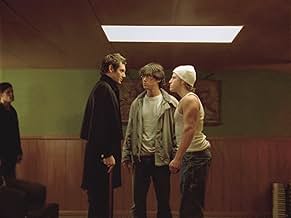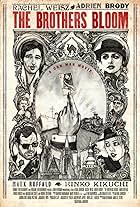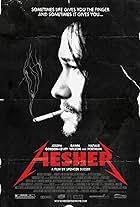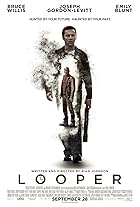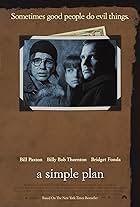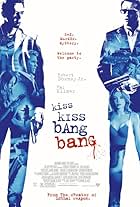A teenage loner pushes his way into the underworld of a high school crime ring to investigate the disappearance of his ex-girlfriend.A teenage loner pushes his way into the underworld of a high school crime ring to investigate the disappearance of his ex-girlfriend.A teenage loner pushes his way into the underworld of a high school crime ring to investigate the disappearance of his ex-girlfriend.
- Awards
- 11 wins & 23 nominations total
Emilie de Ravin
- Emily
- (as Emilie De Ravin)
Tracy Bitterolf
- Straggler
- (as Tracy Wilcoxen)
Ari Welkom
- Tangles
- (as Ari Velkom)
McJoel Hamilton
- The Pin's Driver
- (uncredited)
Lauren Johnson
- Woman Sweeping Backstage
- (uncredited)
- Director
- Writer
- All cast & crew
- Production, box office & more at IMDbPro
Featured review
A life in film if you really commit yourself to it can leave you desperately depressed about the future. The templates are so mature that they are inescapable: without a template somewhere in the field of the thing you simply cannot "read" it, register it.
So you have only a few choices if you are a young filmmaker entering this world. You can buy into the system and play the game as the rivers flow. You can become a stylist in some way.
Or you can play with the templates and forms, usually in a self-referential way. When I see this last as the choice a young filmmaker makes, I rejoice. And it is sheer pleasure when it is done well.
This is. And its existence will make you optimistic, probably just knowing it is there.
Here's what it is: a hardboiled detective story transplanted not into high school (as it appears) but into the abstractions of high school that movies have invented. These two genres each have their own set of abstractions that flatten the world. This fellow has overlapped them. He's suppressed all irony what is usually called irony but is actually selfawareness.
For this to work, all the characters have to be locked in their own world(s) and never glimpse anything outside the flatland. Its expertly done here, just gloriously. The editing is banal (which is a real problem) but the blocking is every bit as inspired as the placement of the thing in terms of the ordinary world of movies.
One example: our hero has been stereotypically beaten and is in a car trunk on his way to meet the local drug kingpin, who is another teen operating out of his Mom's basement. There's a game of light and darkness in this sequence: being blacked out with fists, darkness in the trunk and surreptitiously peering out. Once we are in the house down the cellar stairs there is a short hallway between the bottom of the stairs and a small basement room, the hub. This room is cheap fake wood panelling and low ceiling. Cheap lamps. But before we get there, we get a flash of light when the door opens and we see the 10 foot hallway is jammed with teen drug soldiers lined against the two walls. Its brilliant.
Kids. They own everything. They control not the future but the way we shape what we have now. When I see stuff like this, I think we might be lucky because if it.
2005 was a bad year for movies. This should be on your short list of best of 2005.
Ted's Evaluation -- 3 of 3: Worth watching.
So you have only a few choices if you are a young filmmaker entering this world. You can buy into the system and play the game as the rivers flow. You can become a stylist in some way.
Or you can play with the templates and forms, usually in a self-referential way. When I see this last as the choice a young filmmaker makes, I rejoice. And it is sheer pleasure when it is done well.
This is. And its existence will make you optimistic, probably just knowing it is there.
Here's what it is: a hardboiled detective story transplanted not into high school (as it appears) but into the abstractions of high school that movies have invented. These two genres each have their own set of abstractions that flatten the world. This fellow has overlapped them. He's suppressed all irony what is usually called irony but is actually selfawareness.
For this to work, all the characters have to be locked in their own world(s) and never glimpse anything outside the flatland. Its expertly done here, just gloriously. The editing is banal (which is a real problem) but the blocking is every bit as inspired as the placement of the thing in terms of the ordinary world of movies.
One example: our hero has been stereotypically beaten and is in a car trunk on his way to meet the local drug kingpin, who is another teen operating out of his Mom's basement. There's a game of light and darkness in this sequence: being blacked out with fists, darkness in the trunk and surreptitiously peering out. Once we are in the house down the cellar stairs there is a short hallway between the bottom of the stairs and a small basement room, the hub. This room is cheap fake wood panelling and low ceiling. Cheap lamps. But before we get there, we get a flash of light when the door opens and we see the 10 foot hallway is jammed with teen drug soldiers lined against the two walls. Its brilliant.
Kids. They own everything. They control not the future but the way we shape what we have now. When I see stuff like this, I think we might be lucky because if it.
2005 was a bad year for movies. This should be on your short list of best of 2005.
Ted's Evaluation -- 3 of 3: Worth watching.
Storyline
Did you know
- TriviaThere's a theory on Rian Johnson's official forum that the The Brain only exists inside Brendan's mind. While Rian will neither confirm nor deny the theory, he has said it is "without a trace of irony, my favorite post on the forum."
- GoofsWhen Brendan is in Tug's trunk on the way to see the Pin for the first time he opens up the trunk to see where the Pin lives. He clearly does not have his glasses on while looking out from the trunk. Yet, in the next scene the camera's vision of the Pin is very blurry until Brendan puts his glasses back on. This makes it impossible for him to have been able to see the numbers on the mailbox without his glasses on.
- Quotes
Brendan Frye: Throw one at me if you want, hash head. I've got all five senses and I slept last night, that puts me six up on the lot of you.
- ConnectionsFeatured in 2006 Independent Spirit Awards (2006)
- SoundtracksThe Sun Whose Rays Are All Ablaze
from "The Mikado"
Music by Arthur Sullivan
Lyrics by W.S. Gilbert
Arranged by Renato Neto
Performed by Nora Zehetner
Details
Box office
- Budget
- $475,000 (estimated)
- Gross US & Canada
- $2,075,743
- Opening weekend US & Canada
- $83,574
- Apr 2, 2006
- Gross worldwide
- $3,947,579
- Runtime1 hour 50 minutes
- Color
- Sound mix
- Aspect ratio
- 1.85 : 1
Contribute to this page
Suggest an edit or add missing content




















